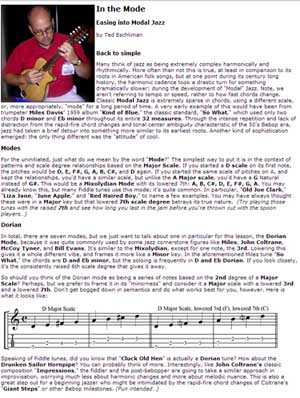« How to Adjust Your Mandolin Action |
Main
| Pencils for All Musicians »
 August 21, 2014 | Easing into Modal Jazz August 21, 2014 | Easing into Modal Jazz
In the December 2008 issue of MandolinSessions.com, we took a look at a kind of throw-back in jazz history back in the late 50's. It was elegant in it's simplicity, and a kind of reaction to the explosion of speed and harmonic intensity. It was the birth of the "Cool."
From the article:
Many think of jazz as being extremely complex harmonically and rhythmically. More often than not this is true, at least in comparison to its roots in American folk songs, but at one point during its century long history, the harmonic cadence took a drastic turn for something dramatically slower: during the development of "Modal" Jazz. Note, we aren't referring to tempo or speed, rather to how fast chords change. Classic Modal Jazz is extremely sparse in chords, using a different scale, or, more appropriately, "mode" for a long period of time. A very early example of this would have been from trumpeter Miles Davis' 1959 album "Kind of Blue," the classic standard, "So What," which used only two chords D minor and Eb minor throughout its entire 32 measures. Through the intense repetition and lack of distraction from the rapid-fire chord changes and tonal center ambiguity characteristic of the 50's Bebop era, jazz had taken a brief detour into something more similar to its earliest roots. Another kind of sophistication emerged: the only thing different was the "attitude" of cool.
Read more: In the Mode; Easing into Modal Jazz

Further:
Animated Sheet Music; So What
Minor 7th chord streams. So What?
Vamps. Minor modal
Reverse Dorian/Minor Arpeggios
Reviewing Scurry Dominants
Posted by Ted at August 21, 2014 9:33 AM

Disclaimer: In the 'Information Age' of the 21st Century,
any fool with a computer, a modem, and an idea can
become a self-professed 'expert." This site does not
come equipped with 'discernment.'
|



